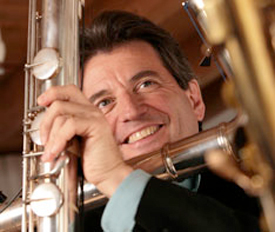by Mike Telin

“I’m looking forward to the gig,” Ziegler said during a Skype video conversation from his home in Zürich. “I’ve been talking with Tom Welsh at the Museum for some time, and now it finally worked out.” The concert will include music from his album, Ukati, as well as from his most recent recording, La Rusna. “I’ll be bringing the alto and normal flutes too, but the focus will be on the bass and contrabass flutes. It will be a mixed program with some experimental abstract things, as well as some pleasant, ear-catching music.”
Ziegler said that he originally got the idea for putting microphones inside the flute after hearing a concert with a didgeridoo. “The player put a microphone inside the instrument, and he produced the most incredible sounds. When I got home, I started experimenting: I put a microphone in my bass flute, and ran it through my home stereo. That’s how everything started.” Ziegler spent the next summer developing techniques, and three generations of equipment later, he said he now has his technology at a very high level.
Amplifying the flute allows Ziegler to increase the volume of the microsound structures of the instrument to an audible level. “The microphones are very small Sennheiser capsules, and are inserted into a cork which fits into a hole in the instrument’s head joint,” Ziegler explained, showing me on his alto flute. Another microphone is positioned on the lower end of the instrument, and a third on the top. “The microphone inside the flute does not affect sound production. It’s very good for creating wind sounds and key clicks, but when I want the normal sound, I can turn off that microphone with a pedal. I actually stand on my left foot, and operate three pedals for volume and loops with my right.”
Ziegler is a 21st century one-man band. “When I travel it is quite an adventure because I have a carbon fiber case the size of a big violin case that holds the bass, contrabass and alto flutes.” He showed me the case, which weighs about 24 pounds. When traveling he also wears a large jacket with many pockets that holds most of the electronics, like the microphones, sound card, power supply and foot pedals. He also has his computer. His normal flute case is strapped to his belt like a sword. Needless to say, getting through airport security is an adventure, but he said the opportunity to perform makes all of the hassles worthwhile.
Did Ziegler always possess an inquisitive nature? “As a kid I was always taking things apart and putting them back together. I played drums, guitar, saxophone, piano, and flute, but I also wanted to be an architect. I started studying architecture and music in school, but after four years of studying both, I left architecture behind and focused on music.”
Wrapping up our conversation, I ask Ziegler to tell me about the track titled Ghashghai from his Ukati CD. “The Ghashghai are a tribe living in the Far province of Iran and they’re famous for their carpets. In 1996 or so I was touring Iran, following the paths of these nomads and I collected some of the melodies I heard in their music. The instrument I use is my matusiflute, which I developed when working with the Swiss harpist, Andres Vollenweider in the 1980’s.
“At first I was using bamboo flutes, one of which had a membrane that vibrated when it was played. The instruments were very out of tune, so I thought that it must be possible to achieve the same sound on a normal flute. So I drilled a hole in a head joint and attached a piece of rice paper, and it worked. The next step was to develop a mute, which stops the vibrating sound.” He located the flute and demonstrated it for me. Yet another fascinating look into the musical life of Matthias Ziegler.
Published on ClevelandClassical.com March 16, 2015.
Click here for a printable copy of this article



